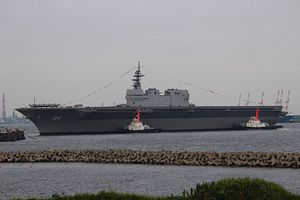JS Kaga, a Japanese Maritime Self-Defense Force (MSDF) helicopter destroyer, was trailed by two Chinese People’s Liberation Army Navy (PLAN) frigates in the South China Sea. A Japanese television network captured the trailing of the vessel on camera. The Chinese warships that trailed JS Kaga appear to be two Type 054A multi-role frigates.
The PLAN’s trailing of the vessel comes not long after JS Kaga, along with a complement of MSDF vessels, completed bilateral exercises with the U.S. Navy in the South China Sea. Starting at the end of August, JS Kaga, the lead ship of the MSDF’s Escort Flotilla 4 Battle Group, Murasame-class destroyer JS Inazuma and the Akizuki-class destroyer JS Suzutsuki joined the U.S. Navy’s USS Ronald Reagan carrier strike group for a bilateral training exercise.
USS Ronald Reagan, a Nimitz-class supercarrier, was joined by the guided-missile cruiser USS Antietam and the guided-missile destroyer USS Milius during the exercises. The United States and Japan began bilateral exercises in the South China Sea starting in October 2015, the same month that the United States commenced freedom of navigation operations to contest China’s excessive maritime claims in the Spratly and Paracel Islands.
Japan has not conducted its own patrols in the South China Sea, but has transited the sea regularly with its naval assets, participated in port calls with friendly states, and engaged in bilateral exercises with the United States. In 2016, China’s ambassador in Japan warned that, in the Chinese view, the MSDF would cross a “red line” if it conducted a freedom of navigation operation in the South China Sea: “Japan is not a concerned party in the South China Sea issue, and has no right to intervene in relevant disputes.”
Earlier this year, at the Shangri-La Dialogue, a defense conference held annually in Singapore, Itsunori Onodera, Japan’s defense minister, said that Japan would “contribute to efforts to maintain it as a free, open, and rules-based ‘global commons,’ that can bring wealth and prosperity to all countries in the region.”
JS Kaga began a two-month deployment in July that would see it enter the Indian Ocean and the South China Sea. JS Izumo, another helicopter destroyer, had undertaken a similar deployment last year to participate in the U.S.-India-Japan trilateral Malabar exercise in the Indian Ocean.
JS Kaga‘s deployment to the South China Sea and Indian Oncea was described by a Japanese defense official as being part of the country’s Indo-Pacific strategy. Japan has been outspoken in its support for the freedom of navigation in the South China Sea where China and six other claimants — Malaysia, Singapore, Brunei, the Philippines, Vietnam, and Taiwan — have competing territorial and maritime claims.
JS Kaga is the second vessel in the 27,000-ton Izumo-class of helicopter destroyers, the MSDF’s largest class of warship. China has regarded the Izumo-class with particular concern amid worries that Japan could refit these vessels to operate F-35B stealth fighters. JS Kaga was commissioned in 2017.

































